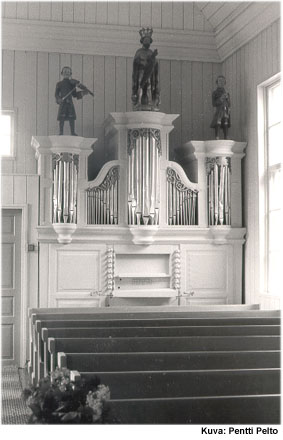|
HISTORICAL ORGANS IN FINLAND 
Jepua Church- Beijer, veljekset 1685
- 8 stops, 1 manual and pull-down pedal
- mechanical action and mechanical stop action
The cruciform Jepua Church was built by Johan Erik Thomasson Romar in 1861. At the end of its north transept is an old organ whose history is something of a mystery. According to Juhani Martikainen, this is almost certainly the organ originally built by Johan and Christian Beijer in the loft to the left of the altar in Pedersöre Church in 1685.
In 1714, during the period of Russian occupation known as the ‘Great Hate’, the Pedersöre organ was damaged so badly that only some of the wood parts and the bellows remained. Henric Kahelin repaired the instrument in 1774. It has been conjectured that Kahelin also originally built the instrument, but this does not appear to be the case.
Anders Gästrin, organist of Uusikaarlepyy, moved the Pedersöre organ to the loft of Jepua Church in 1888. The organ was used until the acquisition of a new organ in 1963. At this point, the old instrument — by now unplayable — was moved to the floor level. Although it sustained further damage during the move and lost some of its pipes, it is possible to gain an overall impression of its appearance. Because of its age, the Jepua organ is an important chapter in the history of Finnish organs.
Façade
The façade of the Jepua organ is in five sections: in the middle is a large round tower and on the flanks are smaller towers; between these are two flats topped by a corniche-shaped arch. This design is in keeping with standard practice in the Kingdom of Sweden (of which Finland was part) in the 17th and 18th centuries. However, there are certain unusual features in the façade, such as the coffered decorations of the pillars, which are rare in Finland. The three carved figures on top of the organ deserve a special mention. In the middle stands King David with his harp. On the flanking towers there are two military musicians attired as noblemen, with swords on their belts; the musicians play the oboe and the violin.
The façade seems low for its width, so much so that its proportions seem distorted. The façade bears clear indications that it has been cut down to size, although it is not known how and when this happened. In any case, it must have become necessary when the organ was brought to Jepua.
The organ case is of equal width from top to bottom, and rather shallow. As was the practice in the Baroque era, it is made of frames joined at the corners. The apertures in the frames are covered with shutters, some of which are hinged.
Technical features
The organ case forms the frame of the instrument, supporting the entire action. All pipes are on top of the chest, the console is in the middle of the front wall, and the action runs from the keyboard to the valves in the chest from the underside. The large stop knobs, with ample movement, are on either side of the music stand. The bellows must originally have been housed in the lower part of the organ case, since there was no other place for them in Pedersöre Church. In the loft of Jepua Church there was a separate cabinet for the newer bellows behind the organ. The bellows are preserved, being stored at present in an anteroom of the church vestibule, but the cabinet has been lost.
The structure of the organ case is fairly rough, but the present windchest is crafted beautifully and with precision. It may have been made by Henric Kahelin in 1774 instead of the brothers Beijer, since its lamellar structure dates it to the 18th century. This dating is corroborated by the chromatic great octave of the chest. The chest has room for eight stops; only six of these were in use when the organ was brought to Jepua. There are traces of two reed stops in the chest.
The disposition is known from the statement of Flintenberg and Telin to Abr. Hülphers regarding the organ in 1766, that is, before the repairs carried out by Kahelin. The stop titles are given below in the form recorded in that statement.
Dispositions
Manual |
|
|
Gedacht 8 fot | | |
Principal 4 fot | | |
Spilflöjt 4 fot | | |
Octav 4 fot | | |
Qvinta 3 fot | | |
Octav 2 fot | | |
Qvinta 1½ fot | | |
Trumpett 8 fot | | |
| | |
| | |
| | |
| | |
| | |
Martti Hela cites the following disposition in the early 1920s:
Manual C-d3 |
|
|
Principal 8’ | | |
Gedacht 8’ | | |
Octava 4’ | | |
Spetsflöjt 4’ | | |
Qvinta 3’ | | |
Octava 2’ | | |
(Mixta noli me tangere) | | |
(Vox Virginea) | | |
| | |
Pull-down pedals C-g0 | | |
| | |
| | |
| | |
Further information
Hela, Martti: Vanhojen urkujemme vaiheita. Porvoo 1924.
Martikainen Juhani: Orglar i Finland från tiden 1600-1800. Sibelius Academy 1997.
|